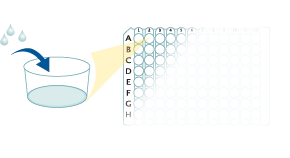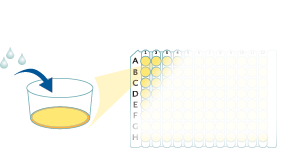Mouse LIX Quantikine ELISA Kit Summary
Product Summary
Recovery
The recovery of mouse LIX spiked to three levels throughout the range of the assay was evaluated.
| Sample Type | Average % Recovery | Range % |
|---|---|---|
| Cell Culture Samples (n=4) | 114 | 105-120 |
| Platelet-poor EDTA Plasma (n=4) | 100 | 92-109 |
| Platelet-poor Heparin Plasma (n=4) | 91 | 85-99 |
| Serum (n=4) | 87 | 82-94 |
| Tissue Homogenates (n=4) | 100 | 87-113 |
| Urine (n=4) | 91 | 84-96 |
Linearity
Scientific Data
Product Datasheets
Preparation and Storage
Background: LIX
LPS-induced CXC chemokine (LIX) is a member of the murine chemokine family. It is 132 amino acids (aa) in length with a predicted molecular weight of 14 kDa prior to cleavage of the N-terminal signal peptide (aa 1–40). LIX has no true human ortholog but is closely related to human CXCL5/ENA-78 and CXCL6/GCP-2. It is widely expressed, and is secreted by multiple cell types including fibroblasts, thymic epithelium, platelets, vascular endothelium, and hepatocytes. LIX acts as a proinflammatory chemokine and is chemotactic for neutrophils.
Assay Procedure
Refer to the product- Prepare all reagents, standard dilutions, and samples as directed in the product insert.
- Remove excess microplate strips from the plate frame, return them to the foil pouch containing the desiccant pack, and reseal.
- Add 50 µL of Assay Diluent to each well.
- Add 50 µL of Standard, control, or sample to each well. Cover with a plate sealer, and incubate at room temperature for 2 hours.
- Aspirate each well and wash, repeating the process 4 times for a total of 5 washes.
- Add 100 µL of Conjugate to each well. Cover with a new plate sealer, and incubate at room temperature for 2 hours.
- Aspirate and wash 5 times.
- Add 100 µL Substrate Solution to each well. Incubate at room temperature for 30 minutes. PROTECT FROM LIGHT.
- Add 100 µL of Stop Solution to each well. Read at 450 nm within 30 minutes. Set wavelength correction to 540 nm or 570 nm.





Citations for Mouse LIX Quantikine ELISA Kit
R&D Systems personnel manually curate a database that contains references using R&D Systems products. The data collected includes not only links to publications in PubMed, but also provides information about sample types, species, and experimental conditions.
13
Citations: Showing 1 - 10
Filter your results:
Filter by:
-
Parkinson's disease-derived ?-synuclein assemblies combined with chronic-type inflammatory cues promote a neurotoxic microglial phenotype
Authors: Yildirim-Balatan, C;Fenyi, A;Besnault, P;Gomez, L;Sepulveda-Diaz, JE;Michel, PP;Melki, R;Hunot, S;
Journal of neuroinflammation
Species: Mouse
Sample Types: Cell Culture Supernates
-
CXCL5 suppression recovers neovascularization and accelerates wound healing in diabetes mellitus
Authors: Chen, C;Lin, LY;Chen, JW;Chang, TT;
Cardiovascular diabetology
Species: Mouse
Sample Types: Serum
-
Platelet-derived chemokines promote skeletal muscle regeneration by guiding neutrophil recruitment to injured muscles
Authors: Graca, FA;Stephan, A;Minden-Birkenmaier, BA;Shirinifard, A;Wang, YD;Demontis, F;Labelle, M;
Nature communications
Species: Mouse
Sample Types: Plasma
-
Stromal FOXF2 suppresses prostate cancer progression and metastasis by enhancing antitumor immunity
Authors: D Jia, Z Zhou, OJ Kwon, L Zhang, X Wei, Y Zhang, M Yi, MP Roudier, MC Regier, R Dumpit, PS Nelson, M Headley, L True, DW Lin, C Morrissey, CJ Creighton, L Xin
Nature Communications, 2022-11-11;13(1):6828.
Species: Mouse
Sample Types: Cell Lysates
-
Targeting HIC1/TGF-beta axis-shaped prostate cancer microenvironment restrains its progression
Authors: T Wu, W Wang, G Shi, M Hao, Y Wang, M Yao, Y Huang, L Du, X Zhang, D Ye, X Bian, J Wang
Cell Death & Disease, 2022-07-19;13(7):624.
Species: Mouse
Sample Types: Serum
-
The Therapeutic Treatment with the GAG-Binding Chemokine Fragment CXCL9(74-103) Attenuates Neutrophilic Inflammation and Lung Dysfunction during Klebsiella pneumoniae Infection in Mice
Authors: D Boff, RC Russo, H Crijns, VLS de Oliveir, MS Mattos, PE Marques, GB Menezes, AT Vieira, MM Teixeira, P Proost, FA Amaral
International Journal of Molecular Sciences, 2022-06-02;23(11):.
Species: Mouse
Sample Types: BALF
-
Protective Effect of Traditional Chinese Medicine Formula RP on Lung Microenvironment in Pre-Metastasis Stage of Breast Cancer
Authors: Y Ye, L Pei, C Wu, S Liu
Integr Cancer Ther, 2019-01-01;18(0):1534735419876.
Species: Mouse
Sample Types: BALF
-
Snail promotes ovarian cancer progression by recruiting myeloid-derived suppressor cells via CXCR2 ligand upregulation
Authors: M Taki, K Abiko, T Baba, J Hamanishi, K Yamaguchi, R Murakami, K Yamanoi, N Horikawa, Y Hosoe, E Nakamura, A Sugiyama, M Mandai, I Konishi, N Matsumura
Nat Commun, 2018-04-27;9(1):1685.
Species: Mouse
Sample Types: Serum
-
Sitagliptin, a dipeptidyl peptidase-4 inhibitor, suppresses CXCL5 and SDF-1 and does not accelerate intestinal neoplasia formation in Apc(Min/+) mice fed a high-fat diet
Authors: K Fujiwara, T Inoue, Y Henmi, Y Hirata, Y Naka, A Hara, K Kakimoto, S Nouda, T Okada, K Kawakami, T Takeuchi, K Higuchi
Oncol Lett, 2017-08-01;14(4):4355-4360.
Species: Mouse
Sample Types: Plasma
-
Upregulation of SOCS3 in lung CD4+ T cells in a mouse model of chronic PA lung infection and suppression of Th17?mediated neutrophil recruitment in exogenous SOCS3 transfer in vitro
Authors: FM Ding, RM Liao, YQ Chen, GG Xie, PY Zhang, P Shao, M Zhang
Mol Med Rep, 2017-05-25;0(0):.
Species: Mouse
Sample Types: Cell Culture Supernates
-
Sharpin Controls Osteogenic Differentiation of Mesenchymal Bone Marrow Cells.
Authors: Jeschke A, Catala-Lehnen P, Sieber S, Bickert T, Schweizer M, Koehne T, Wintges K, Marshall R, Mautner A, Duchstein L, Otto B, Horst A, Amling M, Kreienkamp H, Schinke T
J Immunol, 2015-09-11;195(8):3675-84.
Species: Mouse
Sample Types: Serum
-
Nuclear factor of activated T cells regulates neutrophil recruitment, systemic inflammation, and T-cell dysfunction in abdominal sepsis.
Authors: Zhang S, Luo L, Wang Y, Gomez M, Thorlacius H
Infect Immun, 2014-05-27;82(8):3275-88.
Species: Mouse
Sample Types: Tissue Homogenates
-
Decreased plasma cytokines are associated with low platelet counts in aplastic anemia and immune thrombocytopenic purpura.
J. Thromb. Haemost., 2012-08-01;10(8):1616-23.
Species: Mouse
Sample Types: Plasma
FAQs
No product specific FAQs exist for this product, however you may
View all ELISA FAQsReviews for Mouse LIX Quantikine ELISA Kit
There are currently no reviews for this product. Be the first to review Mouse LIX Quantikine ELISA Kit and earn rewards!
Have you used Mouse LIX Quantikine ELISA Kit?
Submit a review and receive an Amazon gift card.
$25/€18/£15/$25CAN/¥75 Yuan/¥2500 Yen for a review with an image
$10/€7/£6/$10 CAD/¥70 Yuan/¥1110 Yen for a review without an image




